Artist Buttons
Antique Scientific Illustrations

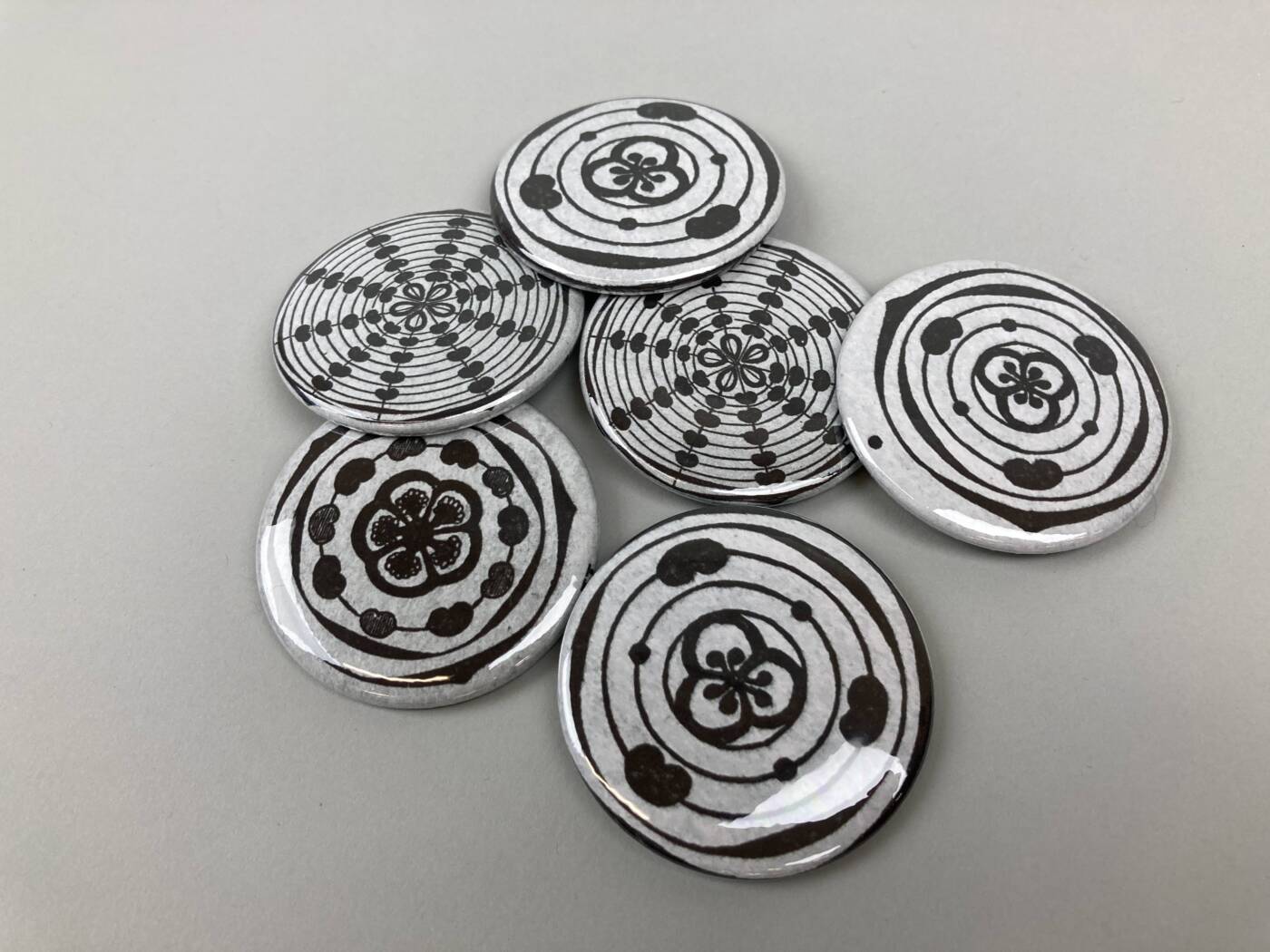


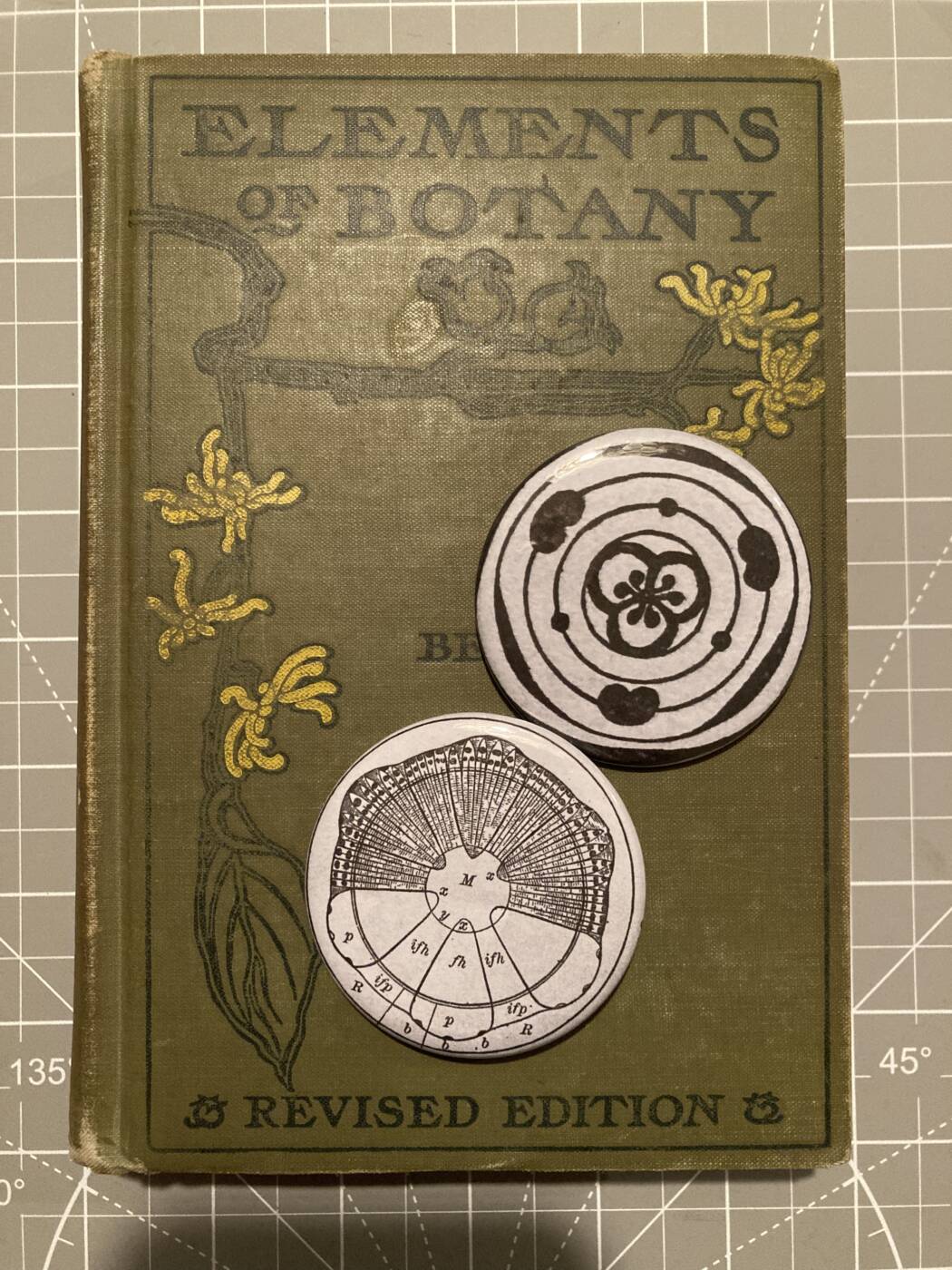
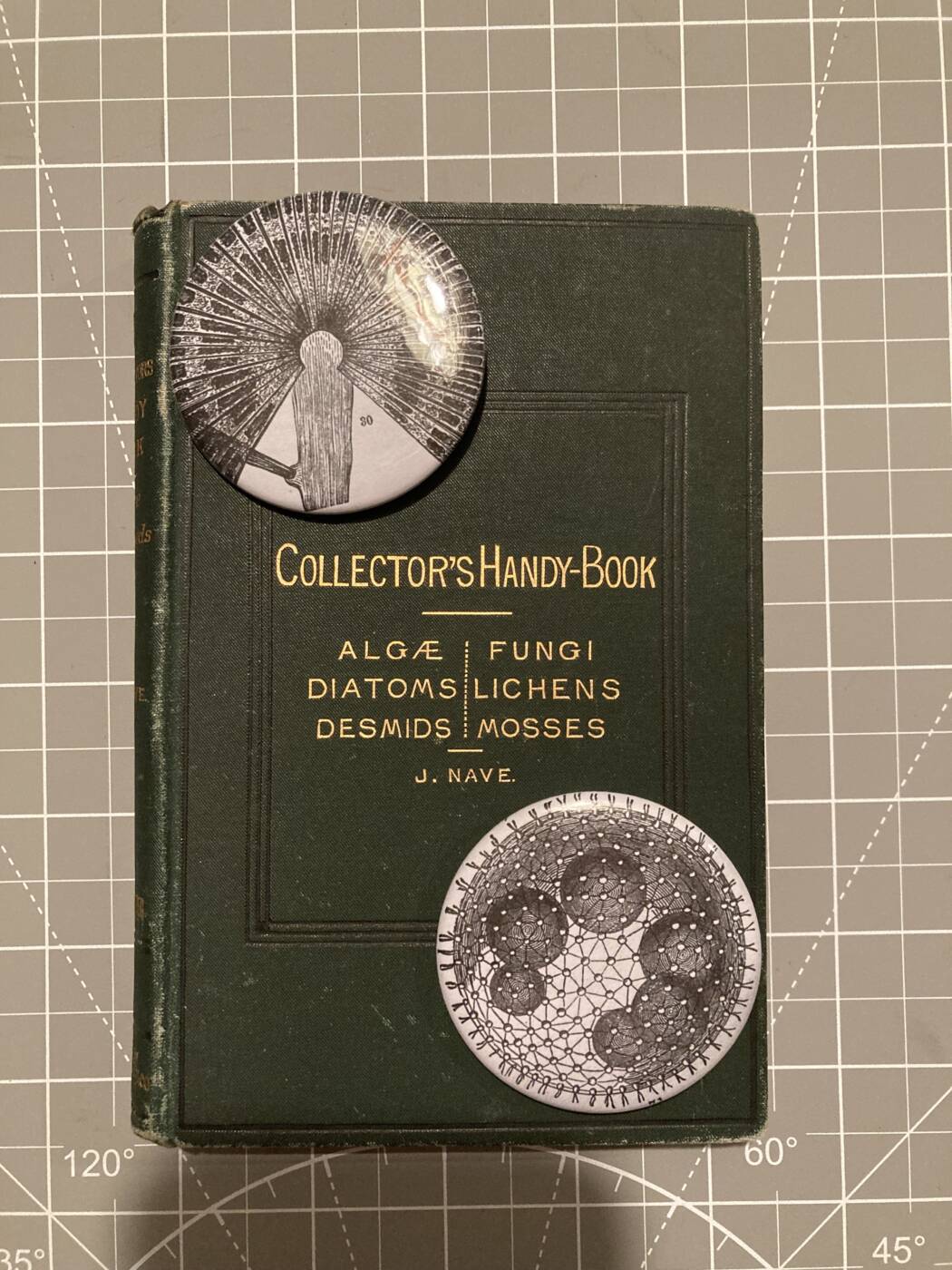
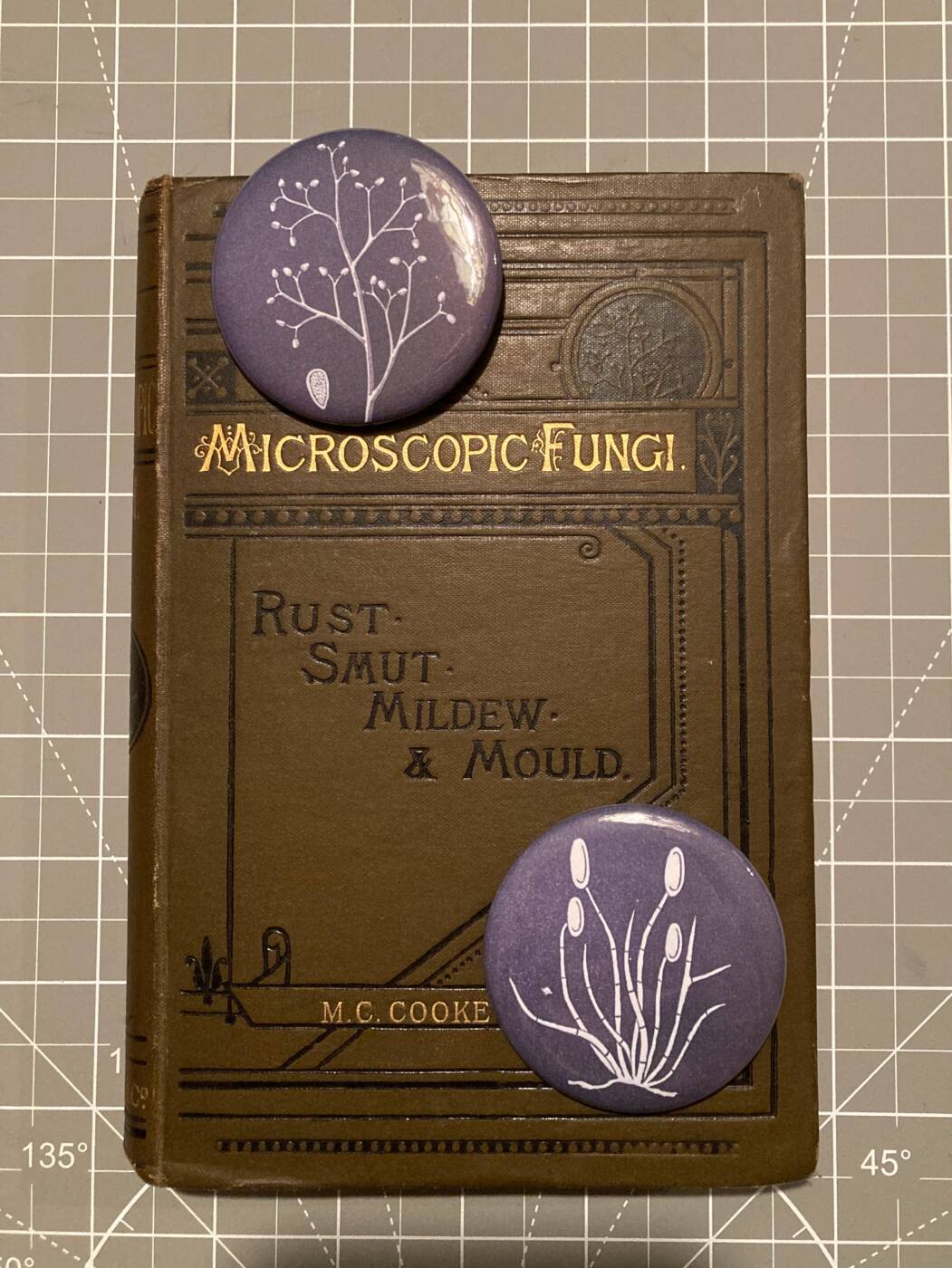
I have a small collection of antique books and I decided to make buttons out of the illustrations in them. I absolutely love the style of old scientific illustrations and I wanted to share them with others. These images have been hidden away in books for over 100 years and now they are back out in the public eye. By putting these illustrations on buttons I intentionally divorced them from accompanying text. In this way, they can be seen as art in their own right, not just supporting visual aids. Without the text to assign meaning to them, the illustrations become open to interpretation. People of different experiences may view them differently. The imagination is free to see whatever it wants.
However, for anyone interested in their original purpose, the illustrations include magnifications of a cell, a germinating spore, algae and mold. Other images depict a cross section of a plant stem and a diagrams of petal and sepal arrangement in flowers.
Portrait of a Research Technician’s Mind
350,000 Insects

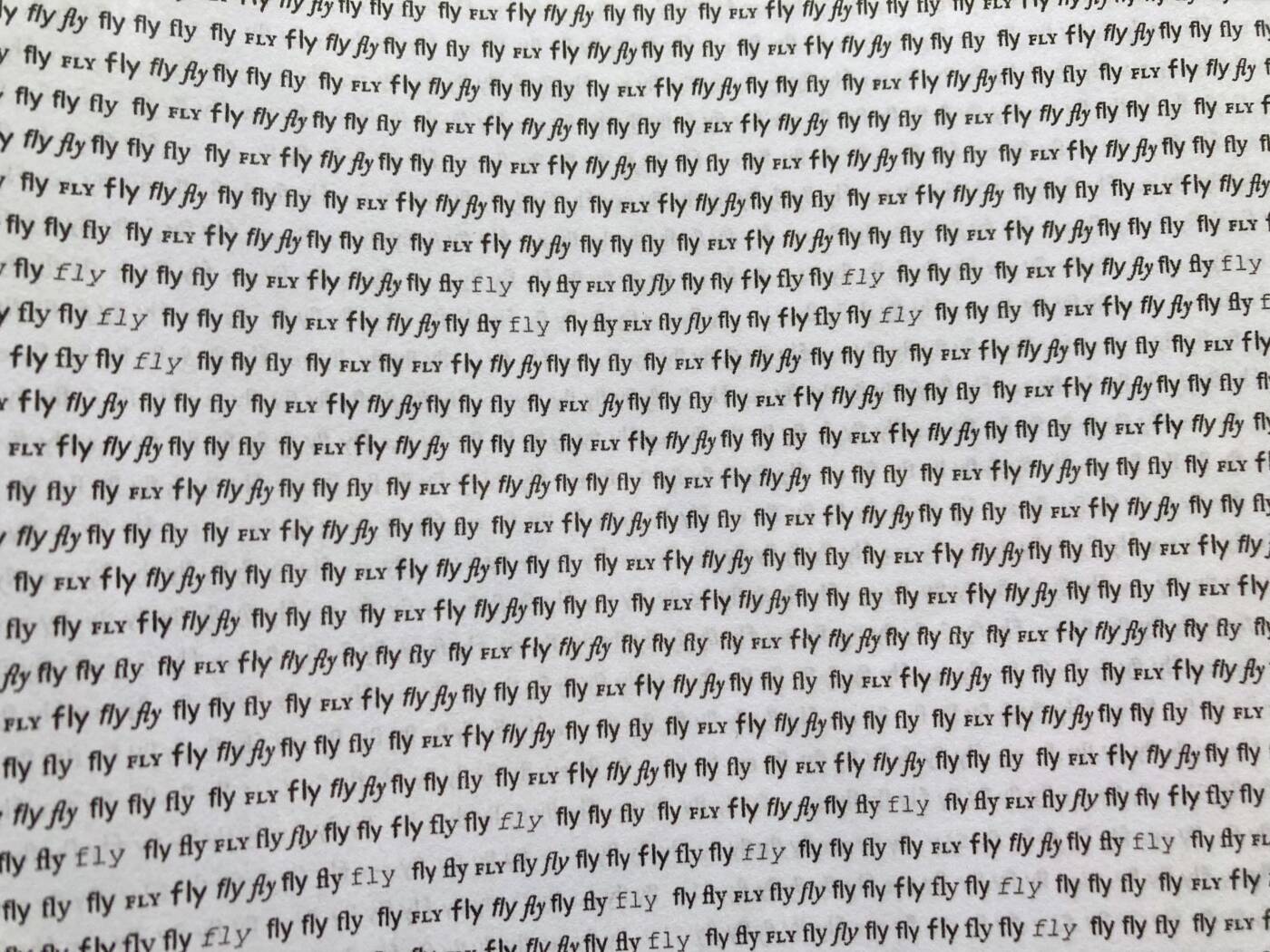
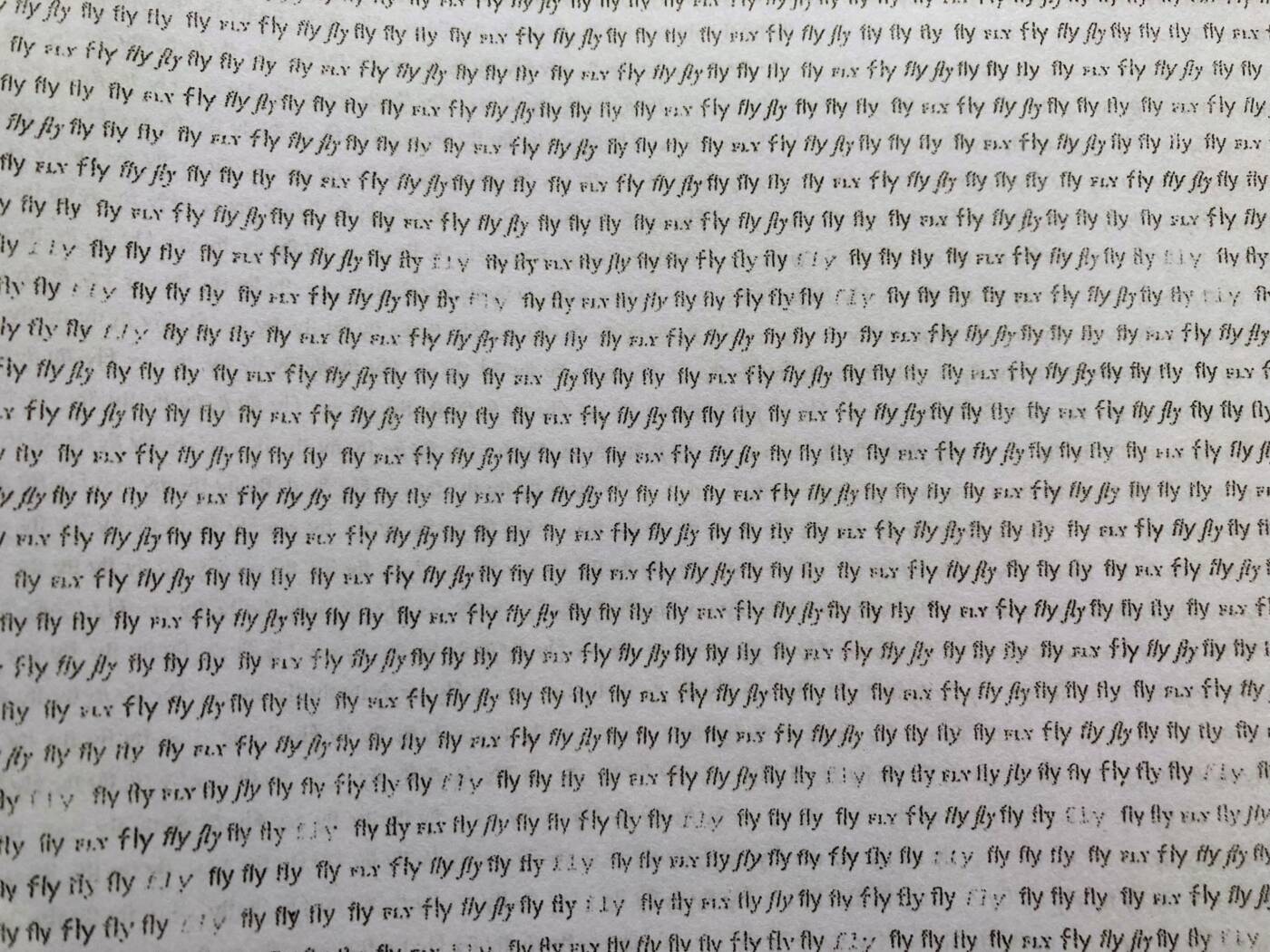
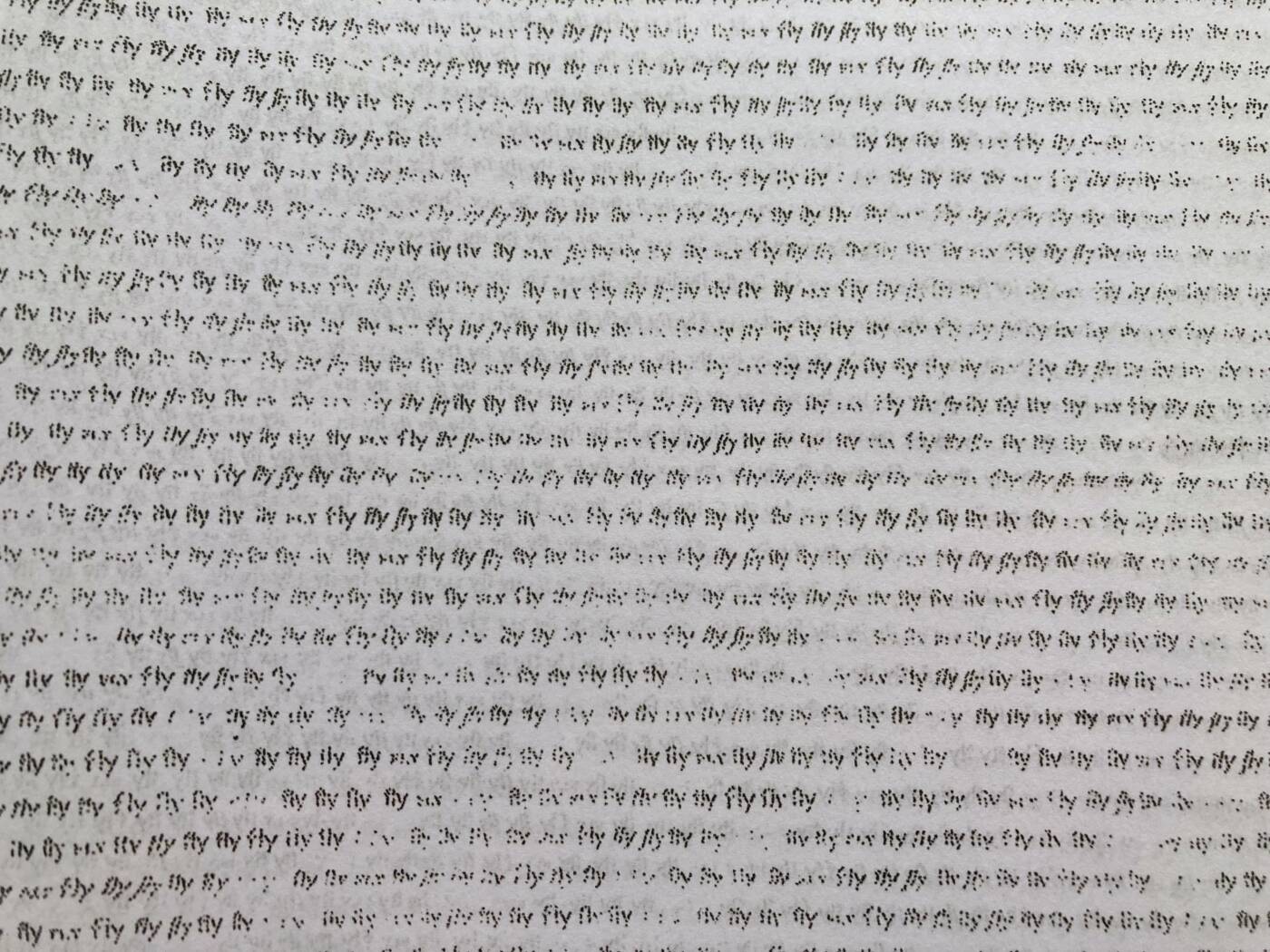
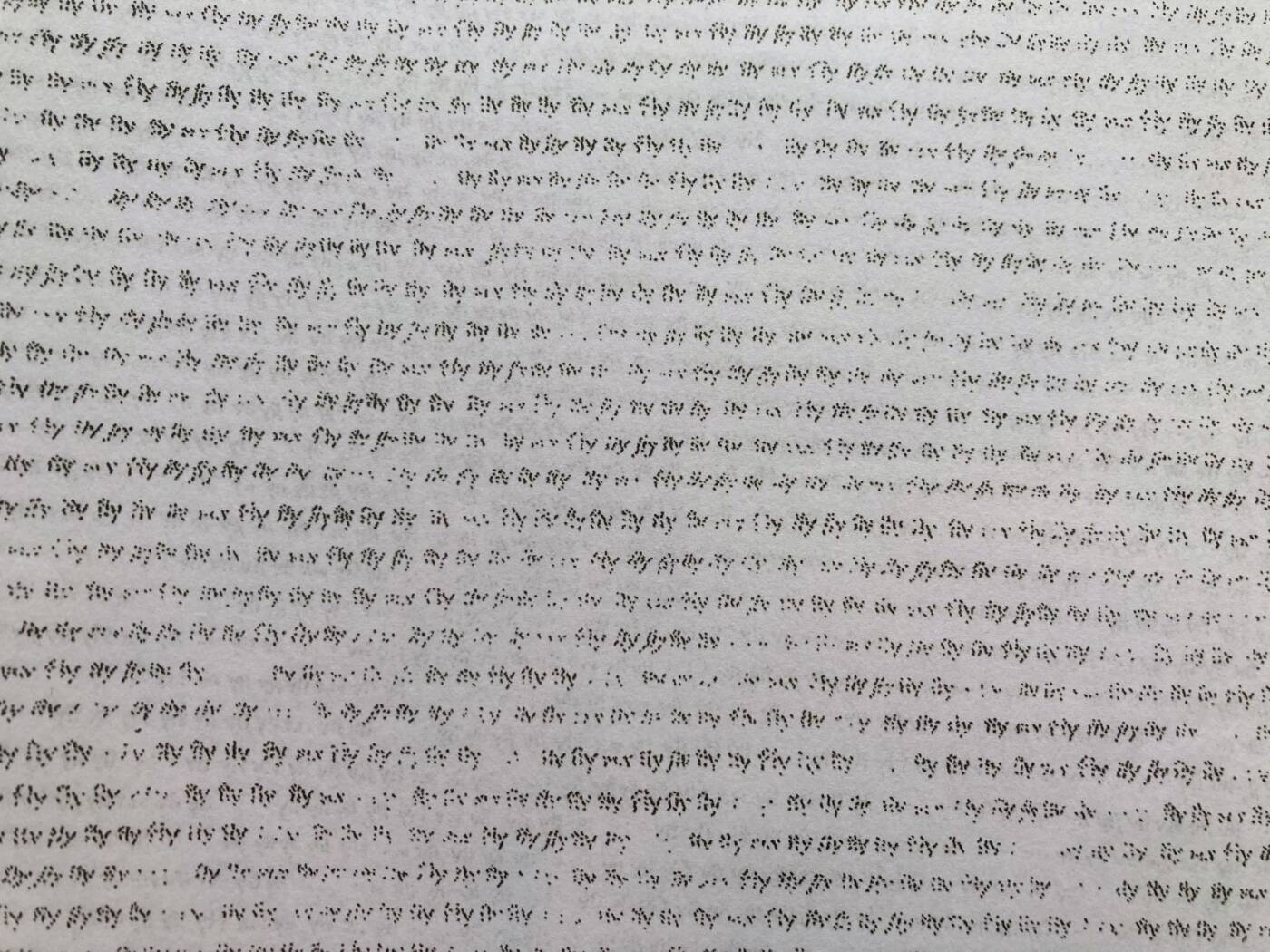


For this project, I wanted to showcase the rigour of scientific endeavour and the opportunity for human error. As a research technician, I sorted and processed over 350,000 insects over the course of 3 years. This work was very repetitive and demanded intense focus. The limits of my attention span and ability to sit still made this work quite tiresome. This inevitably leads to errors being made. To represent the gradual loss of interest and focus that comes with repetitive work, I photocopied the same document over and over again to reduce its resolution. For example, I started with the original document and copied it to make page 2. Then, I copied page 2 to make page 3, page 3 to make page 4 and so on. The greater the quantity of pages made, the lower the quality. The original page featured the word “fly” repeated over and over in different fonts and in a small font size. This mimics the view of the research technician as they look through the microscope at a petri dish containing hundreds to thousands of bugs, most of which are flies. This can be quite jarring to stare at for a prolonged period of time. The limits of the human condition make us prone to error. This is why validation and multiple levels of record checking are so critical in the field of science, where a high level of accuracy is paramount.
Audio Art
The Sound of Silents: 10 Silent Film Climaxes
- 0:00 The General (1926)
- 0:07 The Kid (1921)
- 0:21 Nosferatu (1922)
- 0:35 A Trip to the Moon (1902)
- 0:42 The Cabinet of Dr. Caligari (1920)
- 0:53 Battleship Potemkin (1925)
- 1:02 The Man Who Laughs (1928)
- 1:11 Sparrows (1926)
- 1:23 Metropolis (1927)
- 1:32 Pandora’s Box (1929)
I have always been impressed by the creativity undertaken in silent films. Since they must tell a story under the constraints of having no audible dialogue or background noise, the visuals are pushed to their most creative limits, having a lasting impact on the audience. An accompanying musical score is also heavily relied upon to convey emotion and captivate viewers. As a result, silent films are far from silent. I have made a list of 10 classic silent films and taken a short segment of audio from the most suspenseful moments of each of them. This celebrates moments of loudness in silent films.
One Feat, Three Ways video project
Kaitlin and Mariah
For this project, my partner and I chose to test the limits of flowers. Flowers are a common motif in art and have come to symbolize beauty, nature, femininity and the ephemeral quality of life. As a result, flowers are seen as delicate things that should be handled with great care. We wanted to contrast this notion by experimenting with different actions that destroy flowers. These actions include trimming, tying and plucking. The gradual destruction of these quality, store-bought flowers creates an uncomfortable tension as something beautiful is deliberately destroyed.
Just A Trim (The One-Shot)
Hand-Tied Bouquet (The Sequence)
Pluck (The Loop)
Pipilotti Rist: The World’s Most Colourful Video Artist

1. The image above is of a video installation by Rist titled “Worry Will Vanish Horizon”. The camera slowly swirls and pans across extreme close-ups of the human body. Images of leaves and nature are overlapped with images of the body. The colours are heightened and shifted creating a kaleidoscopic effect. Patterns in leaf venation, blood vessels, finger prints and tree branches can be seen. There are no abrupt changes in the frame. All images transition in and out softly and the overall experience feels like one continuous scene. The video is shot with a small camera attached to the end of a boom. The sound that plays in the background is soft and relaxing. I can hear the strumming of an acoustic guitar as well as some electronic sound effects. This music complements the video by matching its slower pace and enhancing the meditative effect of the experience. The video is 3D projected onto the walls of the gallery. Patron’s shadows are cast on the walls as they move through the space. Visitors are also asked to remove their shoes before they enter the exhibit. There are fluffy duvets on the floor for lounging. All of this aims to further relax and engage the viewer by making them feel comfortable and invited. The projection fills the space and creates an immersive experience. This work strikes me as soothing, warm, meditative and full of an appreciation for life. It feels like a celebration of the wonders of nature, including the human body – how intricate and complex it is.
2. I think there is a strong contrast between Rist’s videos and those on YouTube or TikTok. Videos on social media aim to grab the viewer’s attention immediately and tend to be loud, fast-paced and superficial. Meanwhile Rist’s videos require a longer attention span as they are usually quieter, slower and a meditation on deeper issues. Additionally, social media tends to feature filtered/airbrushed depictions of people (especially women). These people put on their best face and show the highlights of their experience. Rist is more vulnerable and critiques these superficial values in her work. For example, in “Be Nice To Me (Flatten 04)” Rist smushes and smudges her make-up covered face into a clear piece of glass in front of the camera. Her face is pulled into unflattering contortions and her lipstick and eye shadow is rubbed all over the glass and across her face. This is the kind of video I would never see trending on social media as it shows a women spoiling her make-up and behaving strangely or “unlady-like”.
3. I turned my jacket inside-out and walked around campus between classes. I was definitely uncomfortable walking around this way. It was obvious that my jacket was on the wrong way due to the visibility of tags, seems and interior pockets. I felt like people would think I was completely confused or oblivious. However, I did not notice any strange stares (perhaps they were going on behind my back). I think most people are so busy thinking about their own concerns that they probably did not notice. The campus was very busy and I was trying not to stand out. I feel this experiment had a much greater impact on myself than it did an anyone else. For that reason, I did not find this to be a performance. Perhaps, if I tried to directly engage with people while wearing a jacket this way it would have gotten a bigger reaction.
A Kilometre in Calories
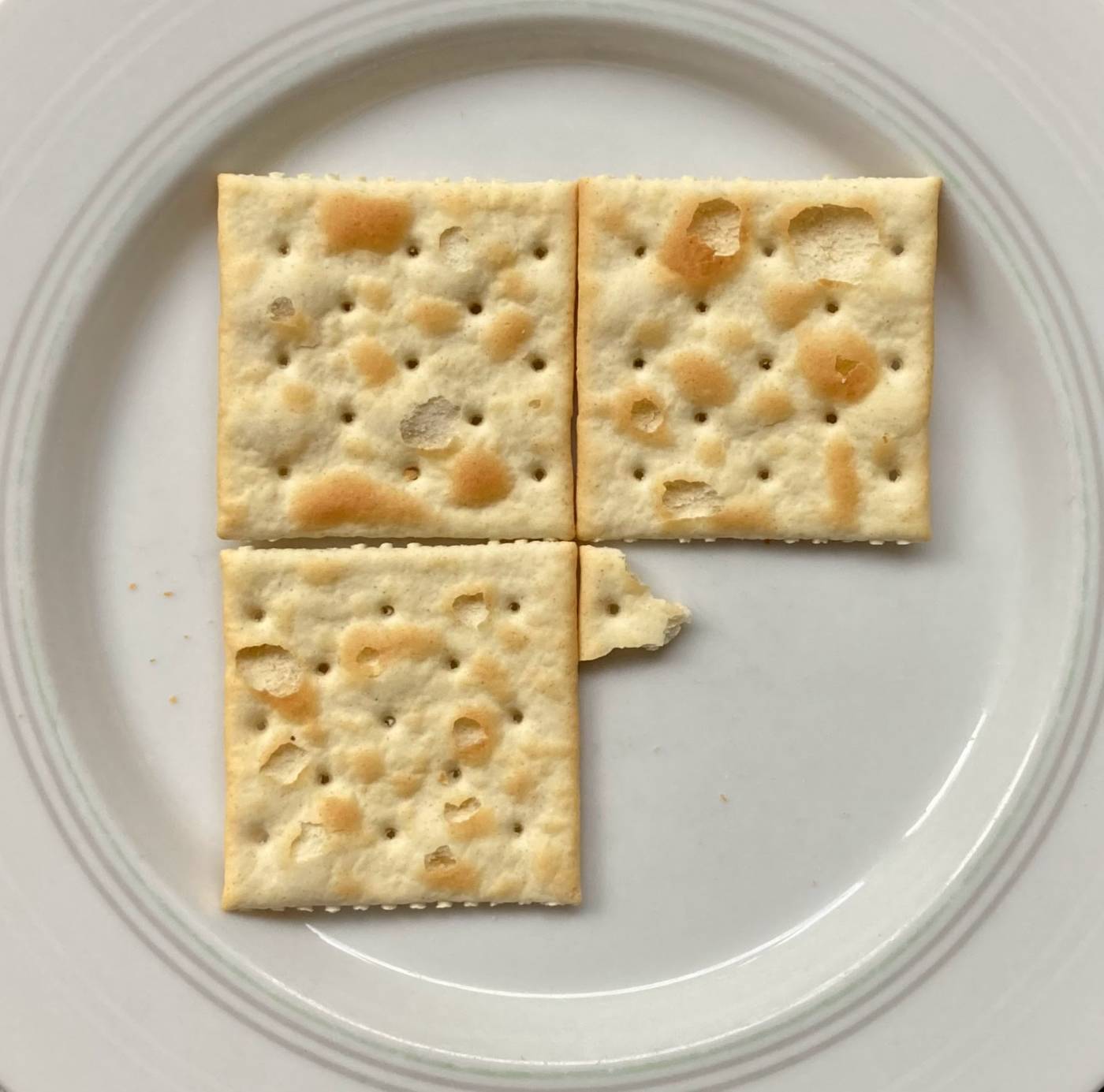
I chose to represent a kilometre in the form of crackers. These 3 (and a bit) crackers contain 41 calories. This is the exact amount of energy I used to walk 1 km along a forested trail last weekend. I felt it would be interesting to visualize a kilometre in terms other than length. Walking a kilometre allowed me to experience the physical effort it requires of myself to travel this distance. To see the small amount of food that fuelled this walk was surprising to me. It has made me appreciate how energy efficient the human body is – how far it gets on seemingly so little. Additionally, it has illustrated the importance physical activity to offset some of the unhealthier, calorie-rich food I enjoy from time to time.
I used the Health app on my phone to measure my distance travelled to ensure my walk was exactly 1 km. I also timed my walk and found it look me 15 minutes to walk this distance. Then, I used an online calorie calculator found here to determine the amount of energy I used. It included factors such as my walking speed, my age, my weight and the duration of the walk. The final result of this calculation was 41 calories.

Marina Abramovic film
My first impressions of Marina’s works are that they are bold, dangerous and emotionally powerful. She places a huge amount of trust in herself, her partner or her audience. In many of her performances she risks her health, safety and even her life. I admire Marina’s courage and stamina. Her performances demand a tremendous amount of bravery as she pushes her limits. She leaves herself vulnerable, opening herself up to a wide array of experiences and deep emotions. The amount of physical and mental strength she utilizes to pull off these feats astounds me. I do find it uncomfortable that she could lose her life with the performances she does, such as in the work below. In the film, her ex husband mentions how she is in love with life. Therefore, her art risks destroying that which she loves most. However, this could be the very element that makes her art so compelling.

Marina’s work has demonstrated to me that performance art requires commitment, complete awareness of the present moment and vulnerability. In her exhibition “The Artist is Present” (photos below) she deeply committed herself to the 3 month time frame despite the pain and other challenges it posed to her. She showed up day after day for months and succeeded in her initial intention for the work. Existing in the present moment is also key during performance art. Marina gave each of her sitters her undivided attention and direct gaze, causing them to give her the same in return. This deep connection between artist and audience heightened the emotional impact of the performance. Finally, vulnerability plays an important role. Two months into her performance piece Marina had the table between her and the guest sitter removed, eliminating a physical buffer. This made the encounters completely direct with no barrier to protect her from the unpredictable actions of the strangers. For viewers and participants, this elevated the power of the performance.


Performance art resists numerous museum and commercial art conventions. It is ephemeral, lasting for only a brief period of time and may only occur once. There is no physical art object to hang on a wall or auction off. It might be shaped or changed by the interaction of an audience. I think some of the themes in Abramovic’s work are best conveyed by the medium of performance. She focuses on pushing her physical and mental limits and the acts she performs create quite a spectacle, especially live. I imagine that watching a video or looking at photos of her works does not compare to the experience of witnessing it in person. I feel that one of the challenges of performance art is it is not appreciated as art by the majority of the general public. This makes is challenging for these artists to be taken seriously. Abramovic explains how she is always questioned “How is this art?”. To navigate this frustration, she pushes herself to extremes in order to evoke stronger reactions from her audience. Perhaps, this is in the aim of trying to gain the public’s respect for performance art as a legitimate art form. I certainly feel she, as a performance artist, has done everything and then some to gain the medium the respect it deserves.
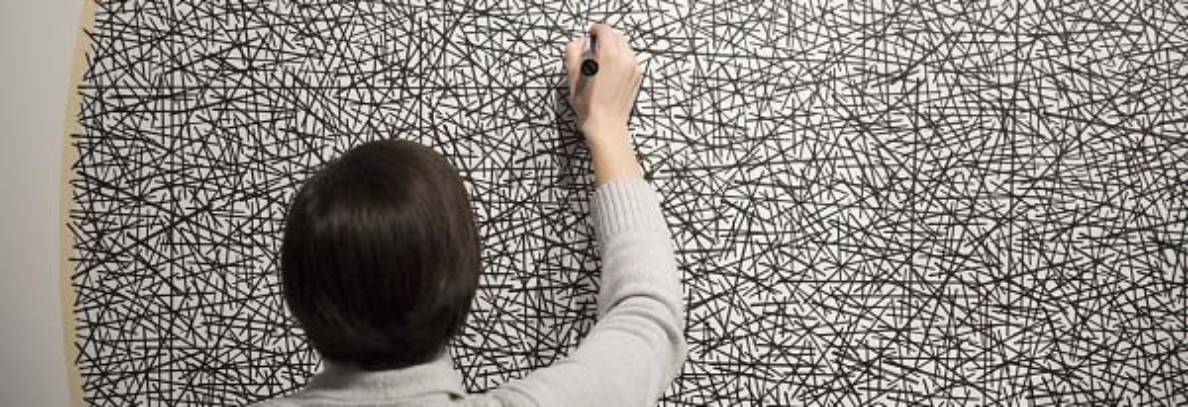
You must be logged in to post a comment.